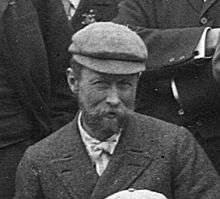Bailey Willis
| Bailey Willis | |
|---|---|
 (1897) | |
| Born |
March 31, 1857 New York |
| Died |
February 19, 1949 (aged 91) Palo Alto, California |
| Nationality | United States |
| Fields | geology |
| Institutions | United States Geological Survey Stanford University |
| Alma mater | Columbia University |
| Notable awards | Penrose Medal (1944) |
Bailey Willis (March 31, 1857, in Idle Wild-on-Hudson, New York, United States – February 19, 1949, in Palo Alto, California) was a geological engineer who worked for the United States Geological Survey (USGS), and lectured at two prominent American universities. He also played a key role in getting Mount Rainier designated as a national park in 1899. After later focusing more on seismology, he became one of the world's leading earthquake experts of his time.[1]
Early life and family
Bailey Willis was born March 31, 1857, the son of poet and publisher Nathaniel Parker Willis and Cornelia Grinnell Willis. At the age of thirteen he was taken to England and Germany for four years of schooling. and thus acquired fluency in German at a time when many scientific texts were only available in that language. He entered Columbia University and in five years completed his studies with the degrees of mechanical (1878) and civil (1879) engineer.
Willis married his cousin, Miss Altona Grinnell, in 1882, but she died in 1896. The couple had two children, Marion, who died in infancy, and Hope, later Mrs. Seward H. Rathbun. In 1898 he married Margaret Baker, daughter of Dr. Frank Baker of Georgetown University, who was also superintendent of the National Zoo in Washington, D.C.. The children of his second marriage are Cornelius G. Willis, Robin Willis and Margaret (Mrs. Donald F.) Smith. The family lived for many years on the Stanford University campus. Mrs. Willis died in 1949.
Career
After receiving degrees in mining engineering and civil engineering, Willis worked from 1881 to 1884 as a survey geologist for Northern Pacific Railroad. From 1884 to 1915, he worked for the USGS, being named director of the Appalachian division in 1889. In 1893 he published "The Mechanics of Appalachian Structure"[2] in the Report of the United States Geological Survey. From 1895 to 1902 he lectured on geology at Johns Hopkins University. In 1900 he was appointed as head of the Division of Areal Geology of the USGS. In 1903 he accepted the invitation of the newly established Carnegie Institution of Washington to lead an expedition to northern China, an experience which was later described in his book Friendly China. From 1910 until 1914 he consulted for the government of Argentina[3] an experience later recorded in his book a Yanqui in Patagonia. He led a vigorous public campaign in the 1920s to raise awareness of earthquake hazards and safe building practices. After finishing his work with the USGS, he was appointed as a professor and chairman of the geology department at Stanford University, where he served until 1922. In 1920, he was elected to the National Academy of the Sciences. He was president of the Seismological Society of America from 1921 to 1926, during which time he published his Geologic Structures. In 1928, he published "Continental Drift" in the SP 2: Theory of Continental Drift, by the American Association of Petroleum Geologists, where he rejects the theory. Stating "After considering the theory of continental drift with avowed impartiality, the author concludes by means of geophysical, geological and paleontologic reasoning that it should be rejected, because the original suggestion of the idea sprang from a similarity of form (coast lines of Africa and South America) which in itself constitutes no demonstration, because such a drift would have destroyed the similarity by faulting, and because other contradictions destroy the necessary consequences of the hypothesis." In 1932, he published "Isthmian Links" in the Bulletin of the Geological Society of America.
Honors
Among the numerous honors which came to Willis during his long life, were an honorary Ph.D. degree from the University of Berlin and the Gold Medal of the Société de Géographie of France in 1910, the Legion of Honor, Belgium, in 1936, and in 1944 he was awarded the Penrose Medal by the Geological Society of America.[1]
The Willis Wall on the north face of Mount Rainier is named for him.[4]
References
- 1 2 Smith., Charles H. "Willis, Bailey geology." Some Biogeographers, Evolutionists and Ecologists: Chrono-Biographical Sketches. Accessed 13 March 2008.
- ↑ The Mechanics of Appalachian Structure on Google books
- ↑ Geografía de Panamá: Character and Resources on Internet Archive
- ↑ Majors, Harry M. (1975). Exploring Washington. Van Winkle Publishing Co. p. 125. ISBN 9780918664006.
Further reading
- Blackwelder, Eliot. "Bailey Willis: 1857—1949: A Biographical Memoir". Washington D.C.: National Academy of Sciences, 1961.
- Wills, Bailey. Friendly China: Two Thousand Miles Afoot Among the Chinese. Stanford University Press, 1949.
- View works by Bailey Willis at Biodiversity Heritage Library.
- Willis, Bailey. Continental Drift AAPG Datapages
External links
- Works by or about Bailey Willis at Internet Archive
- Works by Bailey Willis at LibriVox (public domain audiobooks)
